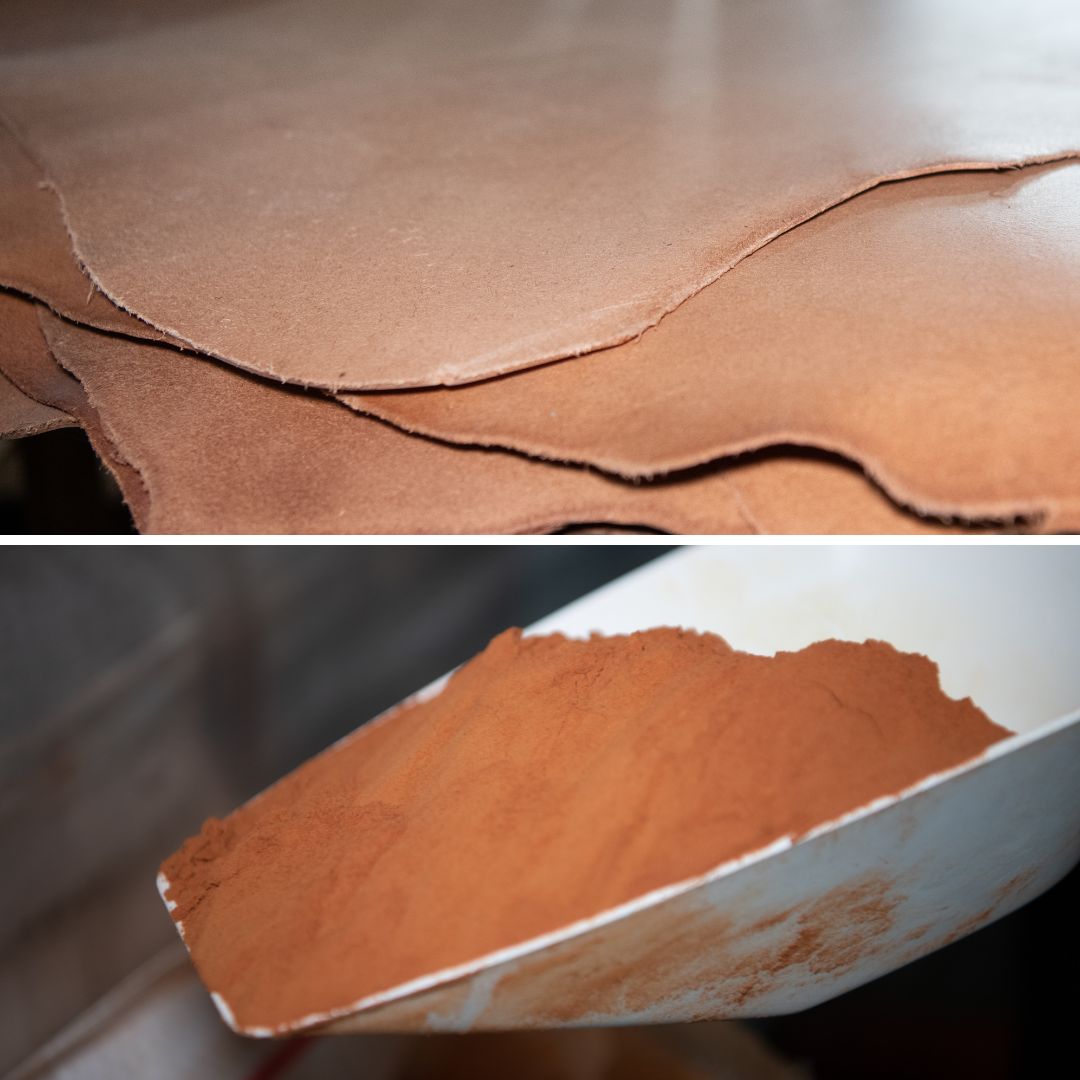Leather is considered one of the best and most durable materials. To reduce costs, manufacturers have found alternatives that contain leather that contain leather and look like real leather. This is the case with reconstituted leather.
Remanufactured leather is a term that often confuses consumers. Products made from this material are generally quite inexpensive, and most consumers feel they are getting a good deal when they purchase an item made from composition leather. But does this thinking hold true in the long run? So that there is no more confusion, we explain what reclaimed leather really is.
What is reconstituted leather?

Reconstituted leather, also known as synthetic leather or artificial leather, is a material made from leather scraps (cuttings or crushed pieces) and binders (PU, PVC, latex, acrylic, etc.). The material is then pressed with a plate that has a pattern to replicate the natural grain of the leather. It also undergoes treatment to mimic the look and feel of real leather. Reconstituted leather generally contains only 10 to 17% real leather.

The manufacturing process for remanufactured leather involves the use of molds and presses to give the material a texture and appearance similar to that of real leather. Remanufactured leather can also be treated with finishes to add shine, flexibility and increased resistance to water and stains.
Rebuilt leather is often used in the manufacture of clothing, footwear, handbags and other fashion items, as well as in furniture and home décor.
Difference between full grain leather and reconstituted leather

The full grain leather is a leather that has kept its upper surface intact. It retains the natural grain and all the characteristics of the hide (suppleness, hold, resistance), including roughness such as natural wrinkles, small scars or healed scratches.
full grain leather is a natural leather, considered the highest quality leather because it is durable, resistant and retains its natural texture and appearance even after prolonged treatment or use. full grain leather is also more breathable.
Reconstituted leather, on the other hand, is made by combining natural leather fibers with synthetic binders. This process creates a material that looks like natural leather, but does not have the same quality or durability as full grain leather. Reconstituted leathers are often used for less expensive fashion and home furnishings items than real leather.
In summary, full grain leather is a high quality natural material, while composition leather is a synthetic material that mimics the appearance of natural leather.
How can you tell the difference between genuine leather and reconstituted leather?

- Price: Rebuilt leather is less expensive than real leather. If the price is very low, it may be a sign that the product is made of remanufactured leather.

- Labeling: Reconstituted leather items are often labeled as "synthetic leather" or "artificial leather". If the item does not mention real leather in its description, it is likely that the material is composition leather.
- Texture and Appearance: Real leather has a natural, irregular texture with visible marks and scars on the surface. In contrast, remanufactured leather has a more uniform texture and can have a more plastic appearance.
- Smell: Real leather has a characteristic leathery smell, while reconstituted leather can have a more chemical or plastic smell.
- Feel: Genuine leather is soft and supple to the touch, while reconstituted leather can be stiffer and less pleasant to the touch.
- Durability: Real leather is more durable than reconstituted leather. It is more resistant to scratches, tears and general wear and tear.
- Resistance to rubbing and tearing. Natural leather is held together by the interlocking fibers of the hide. Reconstituted leather, made from crushed leather, no longer has this resistance.
In summary, it is important to check texture, smell, feel, water resistance and durability to distinguish genuine leather from remanufactured leather. It is important to note that these indicators are not always 100% reliable and it is possible that some remanufactured leather products are very difficult to distinguish from genuine leather. If you have any doubts about the authenticity of the leather, it is always advisable to seek the advice of a leather expert or to look for brands and certifications that guarantee the authenticity of the leather.
Reconstituted leather, less expensive but for how long?
The reconstituted leather has several disadvantages compared to real leather:

- Durability: Rebuilt leather is less durable than real leather and is more susceptible to tears, wear and fading. This can be a problem for items that are subjected to regular use. It also loses its shape and texture with heavy use.
- Breathability/Comfort: Rebuilt leather is less breathable than real leather because it is made from synthetic materials that retain heat and sweat. This makes remanufactured leather less comfortable than real leather because it is not as breathable and can cause heat and sweat to build up.
- Maintenance Maintenance : Being more sensitive to stains and marks, reconstituted leather is more difficult to maintain.
-
Appearance: Reconstituted leather can have an artificial and plastic appearance compared to real leather. The texture may be uniform and lack the natural irregularity that is characteristic of real leather. Rebuilt leather will not patina in the same way as real leather.

- Environmental degradation and sustainability: The production of remanufactured leather is more damaging to the environment than the production of real leather, as it involves the use of synthetic chemicals and binders that can be harmful to the environment. In addition, because remanufactured leather is made from synthetic materials that take years to break down, it releases harmful chemicals during disposal.
The life span of remanufactured leather depends on several factors, including the quality of the material, its use, maintenance and the conditions under which it is stored. In general, and according to studies conducted, remanufactured leather has a lifespan of approximately 3 to 5 years.





